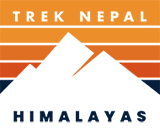Manaslu Circuit Trek
based on 178 reviewsOverview of Manaslu Circuit Trek
Amidst the vast Himalayan ranges, the Manaslu Circuit Trek is swiftly emerging as a favoured alternative to the renowned Annapurna Circuit Trek. It’s not just the magnificence of the mountains that beckon adventurers, but the allure of a less-travelled path.
Indeed, with its relatively recent opening to international trekkers, the Manaslu Circuit promises serenity with fewer crowds. This ensures an intimate communion with nature, untouched landscapes, and authentic cultural experiences.
Yet, it’s essential to remember that the Manaslu Circuit lies in a restricted area, mandating that trekkers obtain a specific Manaslu restricted area permit. This strategic move ensures the region’s pristine nature remains unharmed and cultural norms are respected.
While on the Manaslu Trek, one can’t help but be enamoured by the unique Tibetan-inspired lifestyle. The culture here resonates with ancient Himalayan traditions, offering trekkers a vivid tapestry of customs, rituals, and daily life. For many, this enriching cultural immersion is as awe-inspiring as the snow-capped peaks.
Undoubtedly, the crown jewel of the Manaslu Circuit Trekking adventure is the challenging traverse over the Larke Pass. As one of the loftier Himalayan passes accessible by foot, it promises exhilarating views and an actual test of one’s trekking mettle.
Renowned by some as the Manaslu Larke Pass Trek, the journey encapsulates the rugged challenges of high-altitude trekking and the nuanced beauty of Nepal’s hinterlands. The difficulty level is moderate, making it achievable for those with a reasonable fitness level and a fiery passion for mountains.
One of the benefits of this circuit is the teahouse or lodge trekking experience. Unlike treks where camp setup is needed, the Manaslu Circuit offers the comfort of teahouses, ensuring you’re well-rested for each day’s adventure.
Itinerary of Manaslu Circuit Trek
Begin your Manaslu Circuit Trek in Kathmandu, Nepal’s lively capital. This city, nestled in the Kathmandu Valley, is the perfect gateway to your Himalayan adventure. Here’s a quick guide to kickstart your trek:

Cultural Immersion in Kathmandu
Immerse yourself in Kathmandu’s unique blend of ancient traditions and modernity. Explore UNESCO World Heritage Sites like Swayambhunath and Pashupatinath to soak in Nepal’s rich heritage.
Rest and Gear Up
Utilize your first day in Kathmandu to recover from travel and gear up for the trek. Visit Thamel for quality trekking equipment and ensure you’re well-prepared for the Manaslu Circuit Trek.
Taste Nepali Cuisine
Savour the flavours of Nepal with local dishes like momo and dal bhat. Kathmandu’s culinary scene offers a taste of the diverse flavours you’ll encounter while trekking in Nepal.
Connect with Trekkers
Kathmandu is a hub for trekkers worldwide. Use this opportunity to meet fellow adventurers, share experiences, and gather insights for your journey on the Manaslu Trek Nepal.

Kathmandu is not just a starting point; it’s an integral part of your Manaslu Circuit Trek experience.
Please make the most of your time in this vibrant city to embrace its culture, prepare for your trek, and set the stage for an unforgettable Himalayan adventure.
Kathmandu, Nepal’s vibrant and bustling capital, is the perfect starting point for your adventure on the Manaslu Circuit Trek.
This city, with its unique blend of ancient traditions and modern conveniences, provides an ideal backdrop for the commencement of your trekking journey.
Recovery and Cultural Immersion in Kathmandu
Upon your arrival in Kathmandu, it’s beneficial to take a day to recover from your travels.
This is also an excellent opportunity to immerse yourself in the city’s rich cultural heritage.
Explore the historical sites, like the Kathmandu Durbar Square or the Swayambhunath Stupa, and experience the vibrant life of this dynamic city.
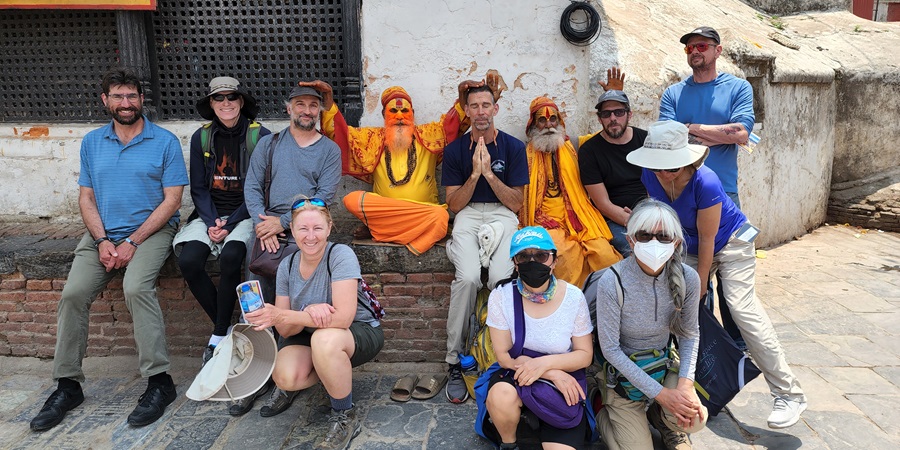
Exceptional Shopping for Trekking Gear
One of Kathmandu’s standout features is its shopping scene, especially regarding trekking gear.
The city offers a wide range of high-quality equipment suitable for the Manaslu Circuit Trek.
Whether you need reliable hiking boots, insulated clothing, or vital trekking accessories, Kathmandu’s shops cater to all your trekking needs.
Securing the Manaslu Restricted Area Permit
Before embarking on the Manaslu Trek Nepal, obtaining the Manaslu Restricted Area Permit is crucial. This permit is essential as the trek navigates through protected regions.
Securing your permit in Kathmandu ensures all necessary paperwork is in order, facilitating a smooth start to your trekking experience.
Kathmandu: The Gateway to Your Trek
Utilize your time in Kathmandu to explore its cultural richness and prepare adequately for your trek. Kathmandu is the ultimate gateway to the Manaslu Circuit Trek, from stocking up on essentials to obtaining permits.
Embarking on the Manaslu Circuit Trek
As you venture onto the less-travelled paths of the Manaslu Circuit, anticipate a journey filled with awe-inspiring landscapes, cultural immersion, and the challenge of traversing the Larke Pass.
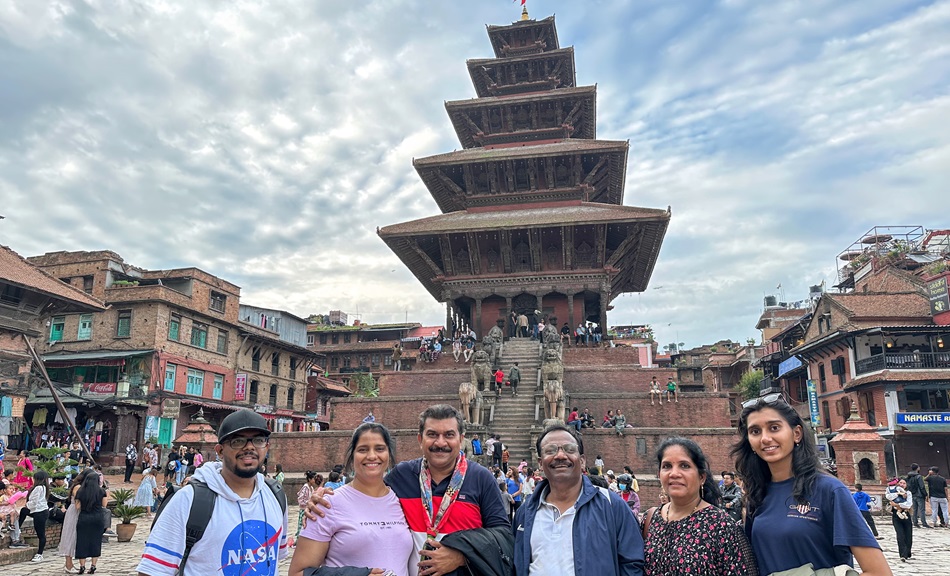
The trek promises to be an extraordinary experience, combining the thrill of adventure with the beauty of the Himalayas.
In conclusion, Kathmandu is not just a starting point for your Manaslu Circuit Trek; it’s a part of the adventure.
Take advantage of your time in this captivating city to fully prepare for the incredible journey that awaits you on one of Nepal’s most beautiful trekking routes.
As you depart from the bustling city of Kathmandu, you’re about to embark on a picturesque drive to Machha Khola, the gateway to your adventure on the Manaslu Circuit Trek.
This drive marks the transition from urban chaos to serene natural beauty, setting the stage for an incredible trekking experience.
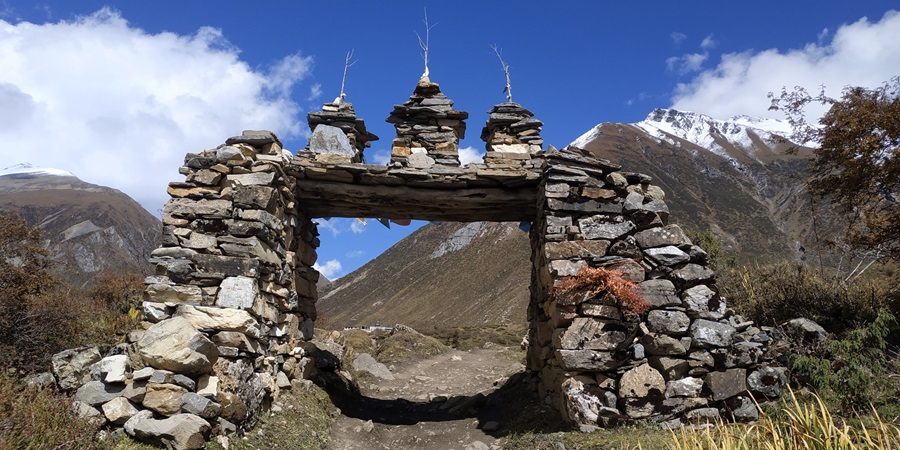
Embrace the Fresh Mountain Air
Leaving Kathmandu, you’ll immediately notice the change in the air – fresher, cooler, and invigorating. It signals that you’re entering a world far from city life, where nature reigns supreme.
An Authentic Trekking Experience in Nepal
The Manaslu Circuit Trek offers an authentic trekking experience, distinguished by its status as one of the less-travelled routes in Nepal.
This makes it ideal for adventurers seeking a quieter, more immersive Himalayan experience.
As you trek through the Manaslu region, you’ll be treated to stunning landscapes, diverse cultures, and tranquillity only in these off-the-beaten-path locations.
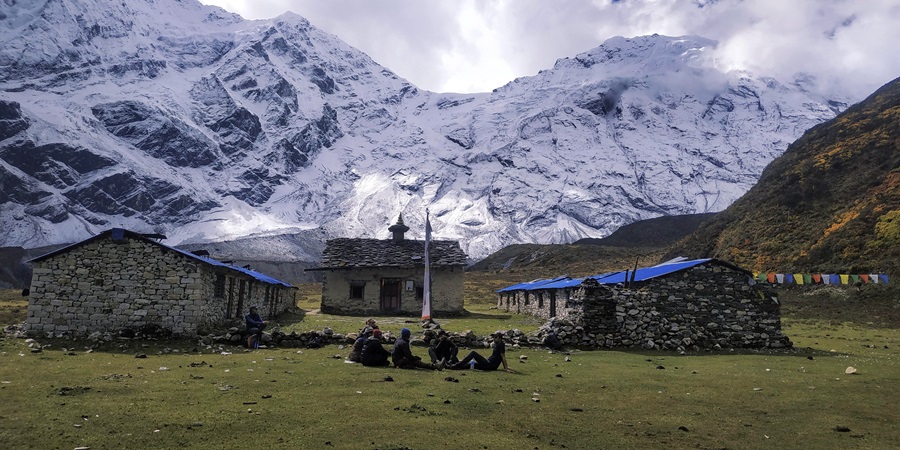
Prepare in Kathmandu
Before you set off, Kathmandu offers excellent shopping options for trekking gear. From high-quality hiking boots to thermal layers, you can find everything you need for your journey in the city’s many shops.
This preparation is part of the excitement, a prelude to the adventure.
Secure Your Manaslu Restricted Area Permit
Don’t forget to secure your Manaslu restricted area permit, a vital document for trekking in this unique region.
This permit is not just a formality; it’s a key that unlocks the beauty and solitude of the Manaslu Circuit, ensuring the preservation and sustainability of this pristine trekking route.
Your Adventure Awaits
With preparations complete and your permit in hand, your adventure awaits. The journey to Machha Khola is the first step in what promises to be a lifetime journey on the Manaslu Circuit Trek.
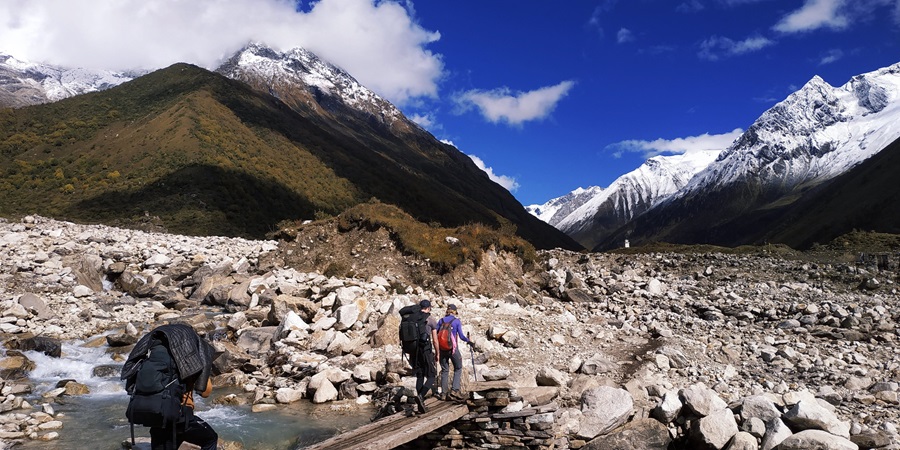
So, take a deep breath, embrace the anticipation, and prepare for an unforgettable trekking experience in Nepal.
Your journey from Kathmandu to Machha Khola is the beginning of an incredible adventure on the Manaslu Circuit Trek.
It’s a path less travelled, offering peace, beauty, and an authentic trekking experience in the heart of the Himalayas. Your adventure in this magnificent region of Nepal awaits!
Embark on an 18-kilometer trek to Dobhan, a crucial and scenic segment of the Manaslu Circuit Trek.
This part of your journey is not just a trek; it’s an immersion into the heart of Nepal’s natural beauty, a key highlight of Manaslu circuit trekking.
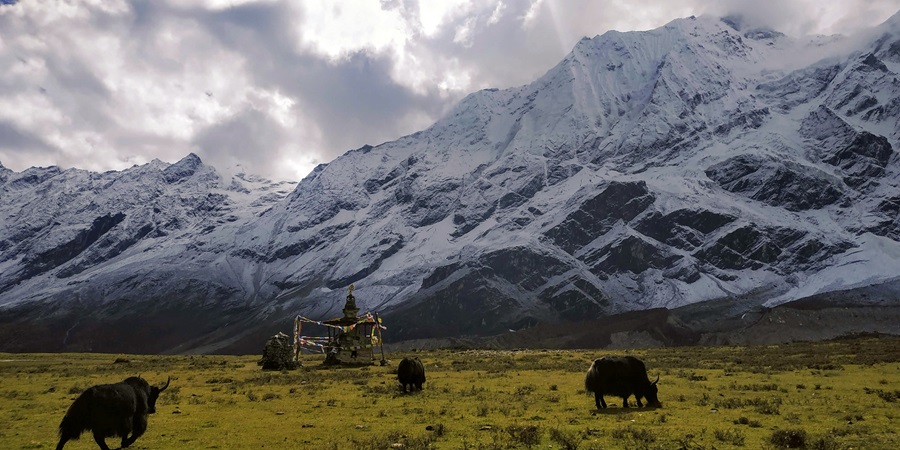
Lush Forests and Babbling Streams of the Manaslu Trek
As you navigate through the lush forests and cross babbling streams, you’re experiencing the quintessential elements of trekking in Nepal.
The Manaslu region, known for its pristine wilderness, offers a trekking experience that is both tranquil and refreshing.
Gradual Elevation Gain on the Manaslu Circuit
The trek to Dobhan features a gradual elevation gain of approximately 70 meters. This ascent is perfectly paced for a smoother adjustment to the Himalayan terrain, a thoughtful aspect of the Manaslu Trek Nepal.
It allows trekkers to acclimatize comfortably, making it a gentle yet rewarding part of the Manaslu Larke Pass Trek.
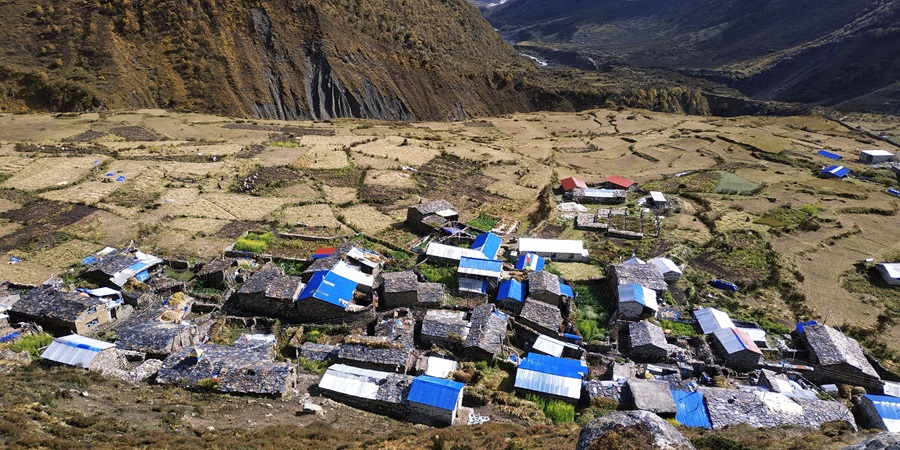
Connecting with Nature on the Trek to Manaslu
This segment of your journey ensures a deeper connection with nature. The breathtaking landscapes and the serene environment make trekking in Manaslu unique and memorable. Each view, from the dense forests to the glistening streams, adds to the enriching experience of the Manaslu Circuit Trek.
Memorable Experience on the Manaslu Circuit Trek
The trek to Dobhan will surely be a highlight of your Himalayan adventure. It encapsulates the essence of what makes the Manaslu Circuit Trek so unique: a blend of natural beauty, cultural richness, and trekking challenge.
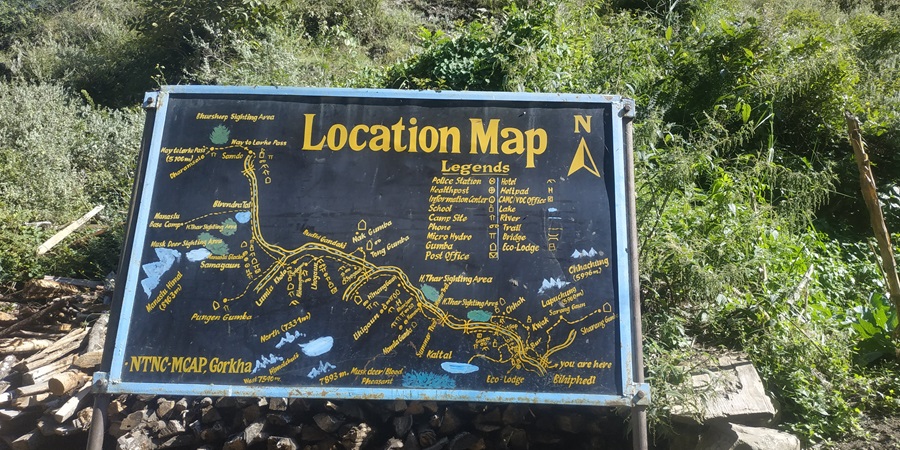
Embark on a captivating 14-kilometer trek, a crucial part of your Manaslu Circuit Trek, leading you to the picturesque village of Philim. This trek is not just a journey through the Himalayas; it’s an immersion into the heart of nature’s splendour.
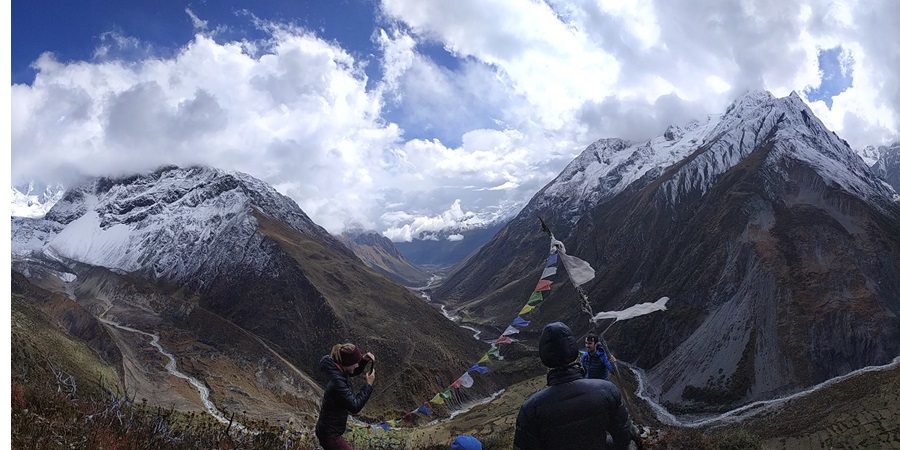
Diverse Landscapes and Lush Terrains
As you set off on this leg of your journey, the diverse landscapes of the Manaslu region unfold before you. Traverse through lush terrain, cross pristine streams, and take the opportunity to observe the region’s unique bird species in their natural habitat. This segment of the Manaslu circuit trekking is a nature lover’s delight.
Terraced Fields – A Glimpse into Local Life
One of the most breathtaking sights on this trek is the terraced fields that dot the landscape.
These fields are not just visually stunning; they offer a glimpse into the traditional farming practices of the local communities, reflecting the harmonious relationship between the people and their land in the Manaslu Trek Nepal.
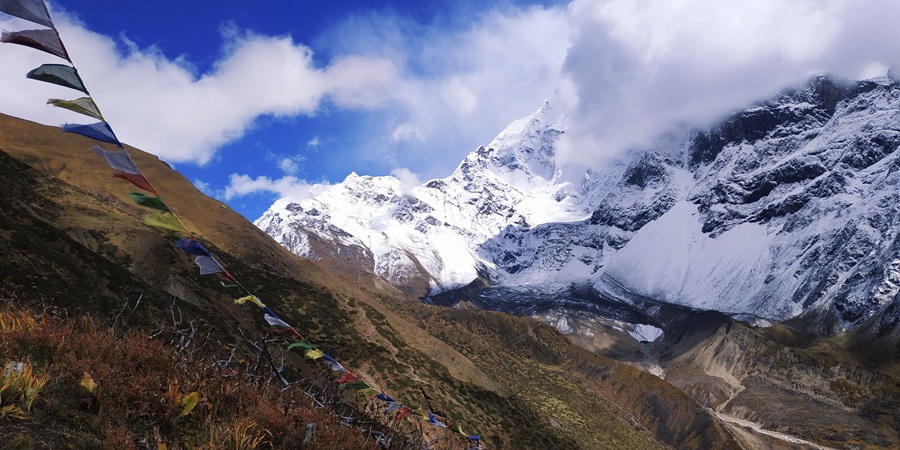
Elevation Gain and Acclimatization
With an elevation gain of approximately 590 meters, today’s trek is designed to help you gradually acclimatize to the increasing altitudes.
This is a crucial aspect of the trek, ensuring a comfortable and enjoyable experience as you ascend higher into the Himalayas.
The Charm of Philim
As you reach Philim, you’ll find yourself in a village with charm and serenity. Philim is not just a stopover; it’s a highlight of the trek to Manaslu, showcasing the region’s cultural richness and natural beauty.
Creating Unforgettable Memories
This journey to Philim on the Manaslu Circuit Trek is an experience that promises to be unforgettable.
Each step of the trek brings new views, new experiences, and a deeper connection with the majestic Himalayas.
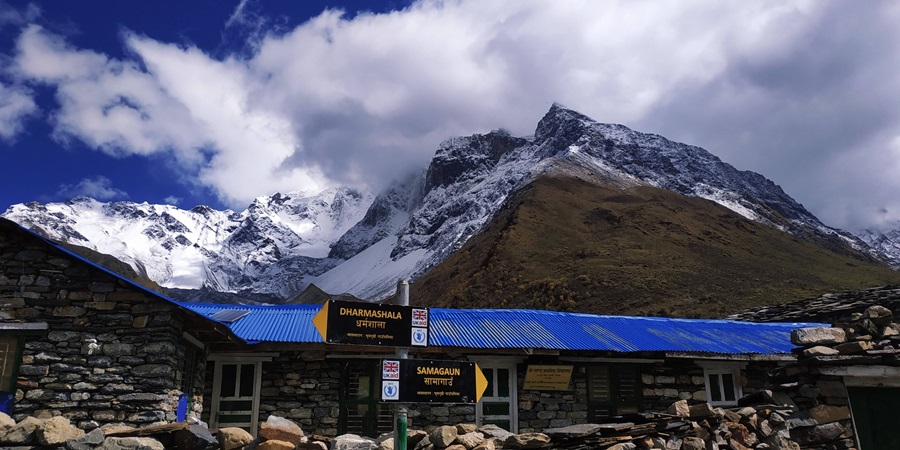
In summary, today’s trek to Philim on the Manaslu Circuit Trek is more than just a physical journey; it explores the heart of the Himalayas.
Enjoy the natural beauty, the cultural insights, and the physical challenge as you make your way through this enchanting part of Nepal, creating memories that will last a lifetime.
Today marks an exhilarating 16-kilometer trek, a significant part of your Manaslu Circuit Trek, as you journey towards the captivating villages of Deng and Ghap.
This trek isn’t just a passage through the Himalayan landscape but a deep dive into the heart of Tibetan-influenced territories.
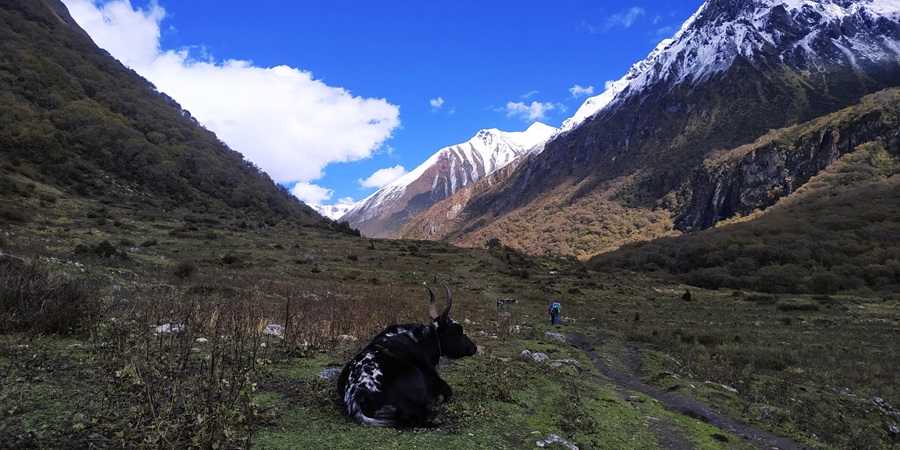
Cultural Transformation in Tibetan Territories
You’ll experience a profound cultural transformation as you delve into these regions. The influence of Tibetan culture is evident in the architecture, the traditions, and the daily lives of the local communities.
This segment of the Manaslu circuit trekking is as much a cultural exploration as a physical journey.
Witness the Mani Walls and Chortens
Look for the remarkable Mani walls and chortens along your path. These enduring symbols of the region’s rich spiritual heritage are cultural treasures and provide profound insights into the centuries-old traditions the local communities preserve. They are a vital aspect of the Manaslu Trek Nepal.
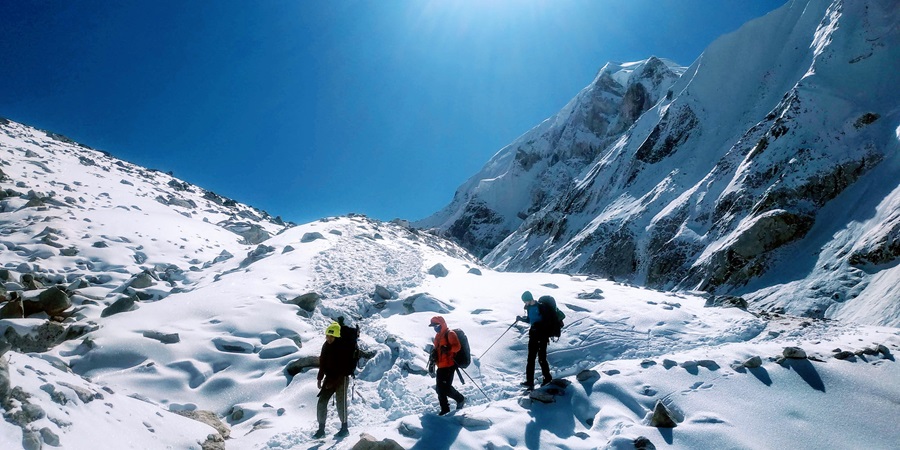
Elevation Gain and Acclimatization
With an elevation gain of approximately 205 meters during this trek, you’ll gradually acclimate to the Himalayan altitudes.
This is a crucial aspect of the trek, ensuring you can fully enjoy and appreciate the journey without the discomfort of altitude sickness.
From Deng to Ghap – A Journey of Splendour
As you traverse from Deng to Ghap, you’ll experience the Manaslu Circuit Trek in all its splendour. The scenery, the culture, and the region’s sheer beauty create an unforgettable trekking experience.
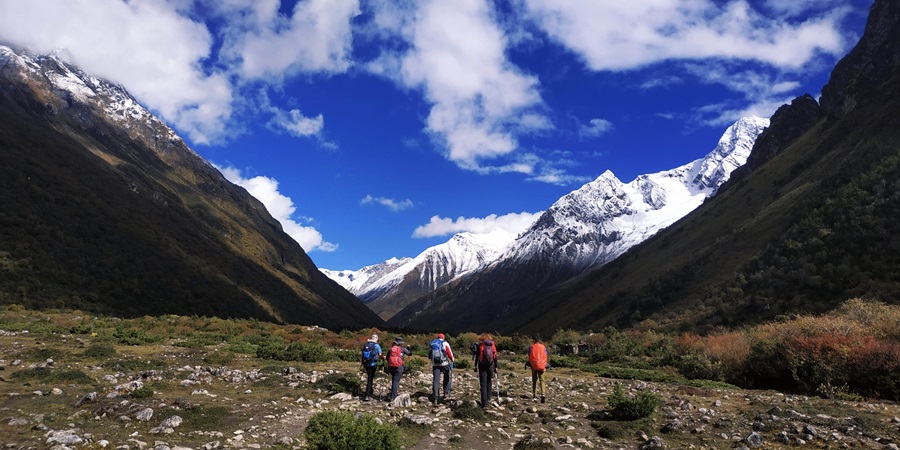
Forging Unforgettable Memories
This leg of your trek is sure to forge unforgettable memories. The combination of captivating culture, serene landscapes, and the warm hospitality of the local communities make this journey a standout experience in your trekking in Nepal adventure.
Today’s trek from Deng to Ghap on the Manaslu Circuit Trek is a journey that encompasses the essence of Himalayan trekking.
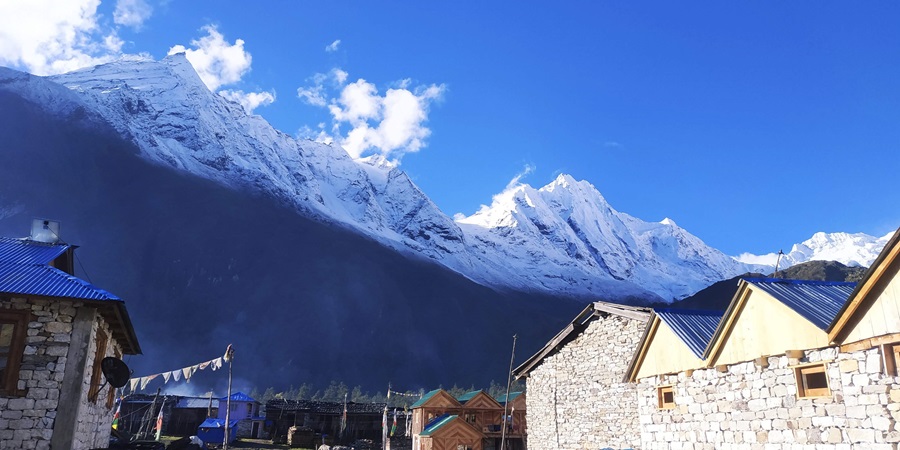
It blends cultural immersion, scenic beauty, and physical challenge, creating an extraordinary and memorable trekking experience. Enjoy each moment as you navigate this unique and mesmerizing part of the Himalayas.
Commence on an unforgettable segment of your Manaslu Circuit Trek as you journey towards Lho.
This part of the trek is nothing short of a natural masterpiece, highlighted by the awe-inspiring presence of Mt. Manaslu dominating the horizon.
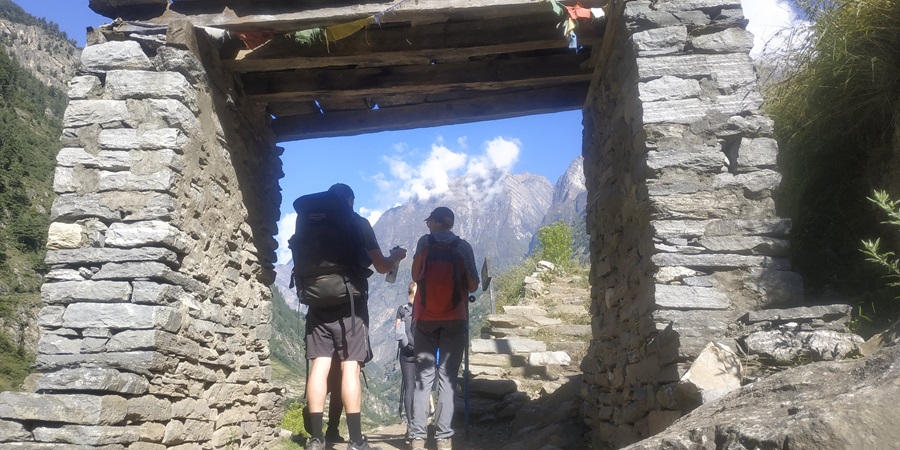
Mt. Manaslu – A Majestic Backdrop
As you trek towards Lho, the grandeur of Mt. Manaslu becomes increasingly palpable.
This towering peak, one of the highest in the world, creates a dramatic and inspiring backdrop, setting the stage for an extraordinary trekking experience.
Capturing Memories Beyond the Lens
As you ascend through the captivating terrain, remember to capture these moments not only through your camera but also in your heart.
The landscapes you’ll encounter are more than just visually stunning; they’re emotionally resonant, making every step a cherished memory.

Elevation Gain and Acclimatization
The ascent to Lho involves an elevation gain of approximately 1015 meters. This gradual climb is integral to acclimatizing to the higher altitudes, a crucial aspect of Manaslu circuit trekking.
It prepares you physically and mentally for the more challenging journey ahead.
Drawing Nearer to the Himalayan Giants
With each step towards Lho, you draw closer to the towering peaks and pristine beauty of the Manaslu region. This trek is a testament to the awe-inspiring wonders the Manaslu Trek Nepal offers.
It’s a journey that takes you through some of the most beautiful landscapes in the Himalayas and connects you deeply with the natural world.

A Journey to Remember on the Manaslu Circuit
The trek to Lho is a significant and memorable part of the Manaslu Circuit Trek. It’s a day where the overwhelming beauty of the surroundings overshadows the physical challenge of trekking.
It epitomizes why trekking in Nepal, particularly in the Manaslu region, is so revered among trekkers worldwide.
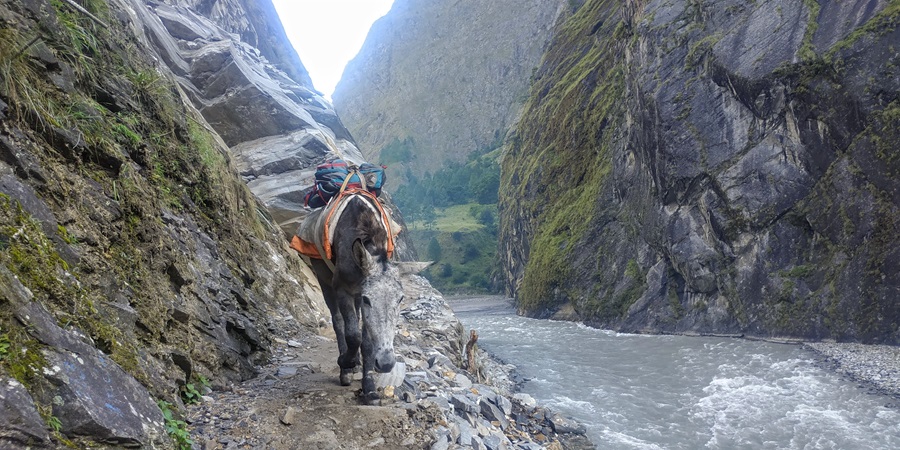
In conclusion, your trek to Lho on the Manaslu Circuit Trek is a journey that combines physical endurance with the sheer joy of being in one of the most breathtaking landscapes on the planet.
Each step brings a new view, appreciation, and a deeper connection with the majestic Himalayas.
Embark on a captivating 8-kilometre journey today as part of your Manaslu Circuit Trek, which transports you into an otherworldly realm.
This leg of the Manaslu circuit trekking adventure is more than just a trek; it’s a passage into a landscape that feels like a different world.

Samagaon’s Unique Landscape
As you approach Samagaon, you’ll be mesmerized by its unique and captivating landscape.
The area presents a striking harmony of towering Himalayan peaks and verdant valleys, offering quintessentially trekking panoramas in Nepal.
It’s a breathtaking juxtaposition that highlights the diverse beauty of the Manaslu trek in Nepal.
Elevation Gain and Acclimatization
Today’s trek involves an elevation gain of approximately 345 meters. This ascent is vital to the Manaslu Larke Pass Trek, helping you acclimate to the increasing altitudes.
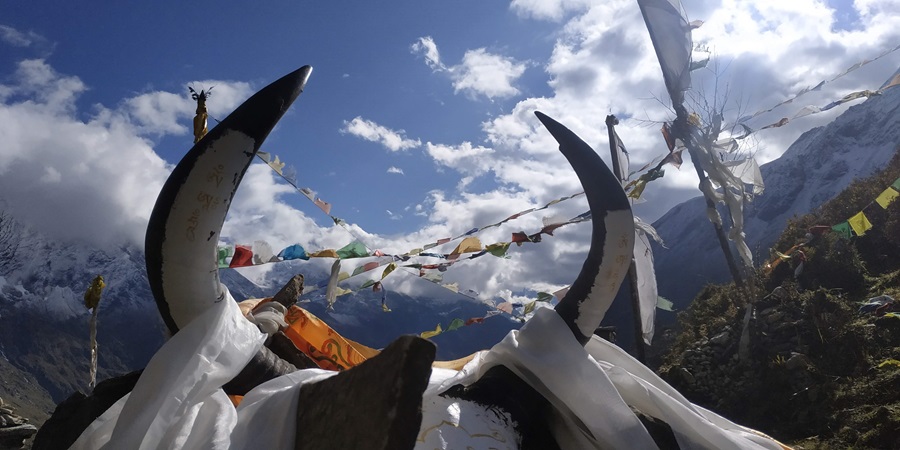
Each step brings you closer to the unique high-altitude environment for which the trek to Manaslu is famous.
The Enchantment of Samagaon
Reaching Samagaon is a moment that many trekkers on the Manaslu Circuit Trek eagerly anticipate. The village is surrounded by majestic heights and lush vistas, making it a standout destination on the circuit.
Its serene beauty and the towering Himalayas create a backdrop that’s nothing short of extraordinary.
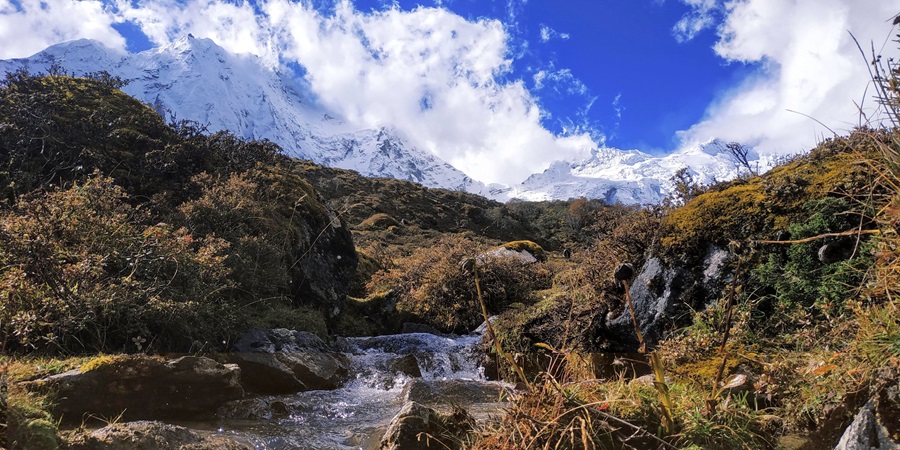
A Highlight of the Manaslu Circuit
Samagaon isn’t just another checkpoint; it’s a highlight of your trekking in Manaslu journey.
The village offers a unique blend of natural grandeur and cultural richness, making it a memorable stop on your trek.
Today presents you with a delightful array of options to tailor your adventure according to your preferences. Choose from various activities catering to different aspects of the Manaslu Circuit Trek experience.
Trek to Manaslu Base Camp: Embark on a trekking journey that leads you to the iconic Manaslu Base Camp.
This exhilarating expedition will allow you to draw closer to the awe-inspiring Manaslu Mountain, offering a firsthand encounter with its grandeur.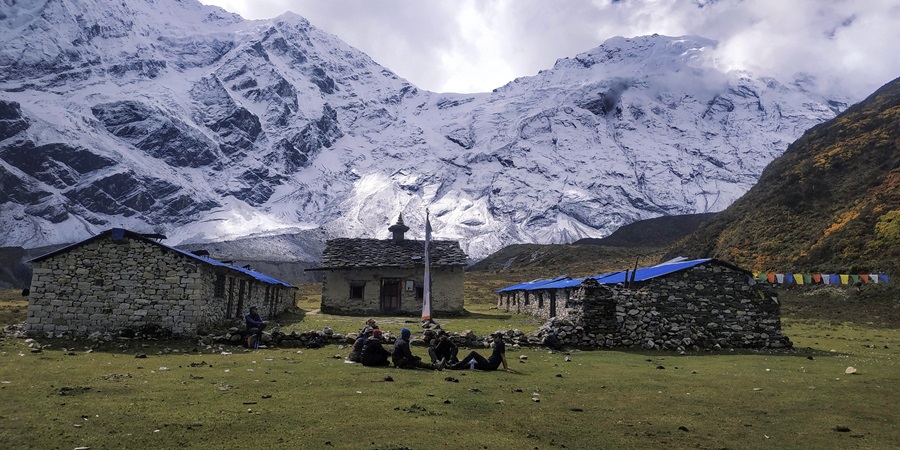
Visit the Ethereal Birendra Lake: The enchanting Birendra Lake is a glacier-fed gem nestled amidst the mountains.
The serene waters of this picturesque lake reflect the surrounding peaks, creating a mesmerizing natural spectacle.
Explore the Spiritual Pungent Gompa: Immerse yourself in the spiritual ambience of Pungent Gompa.
This sacred monastery provides a glimpse into the rich Tibetan Buddhist culture of the region, offering a serene and contemplative experience.
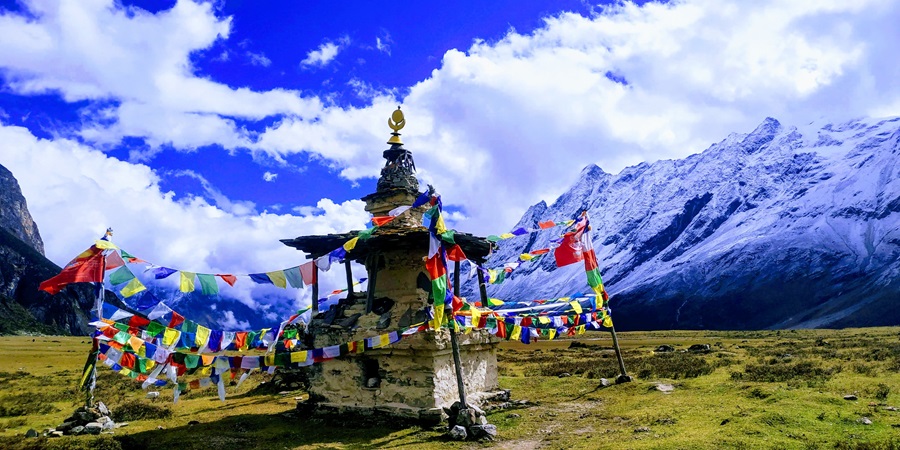
Whichever path you choose for today’s adventure, rest assured that each option is filled with its unique charm and opportunities for discovery, adding another layer of richness to your Manaslu Circuit Trek.
Embark on an 8-kilometer trek today, a pivotal part of the Manaslu Circuit Trek, which will lead you to the charming village of Samdo.
This Manaslu circuit trekking adventure segment will surely be one of your journey’s highlights.
As you traverse this picturesque route, you’ll be treated to some of the most breathtaking alpine scenery the Manaslu Trek Nepal offers.
The path to Samdo is renowned for its stunning vistas, making it a cherished part of the trek for many adventurers.
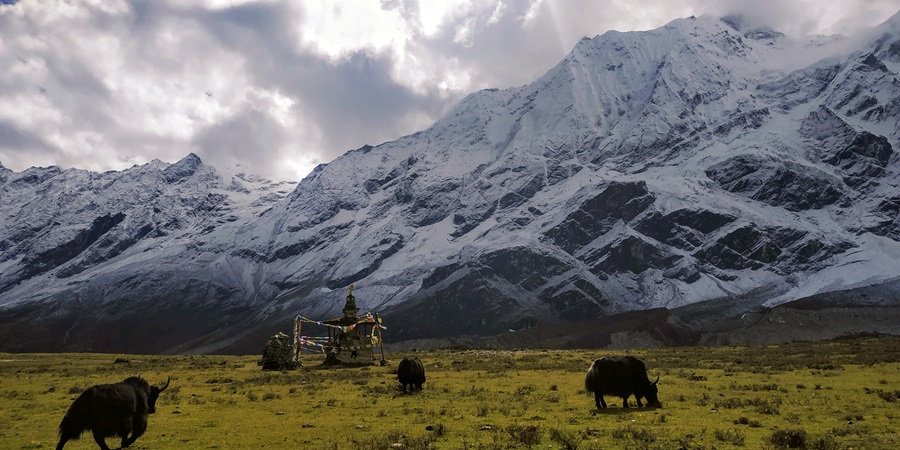
Prepare to be captivated by the sweeping mountain vistas surrounding you throughout this leg of your journey.
This day in your trek to Manaslu is not just about reaching a new destination but about immersing yourself in the raw beauty of the Himalayas.
During this trek, you’ll gain an elevation of 325 meters, enhancing your deep appreciation for the natural beauty and grandeur of the Himalayan range.
This elevation gain is a significant part of the Manaslu Larke Pass Trek, bringing you closer to the unique alpine environment.
Samdo, nestled in the heart of the trekking in Manaslu route, is a destination that will leave you in awe of its alpine charm.
The village and the stunning mountain landscapes that envelop it are quintessential examples of the beauty you encounter while trekking in Nepal.

Enjoy this day of exploration and immersion in the mesmerizing world of the Manaslu Circuit Trek.
It’s a journey that blends challenging trekking with awe-inspiring natural beauty, creating an unforgettable experience in the heart of the Himalayas.
Today’s segment of your Manaslu Circuit Trek is an exhilarating 11-kilometre trek that will challenge your limits while rewarding you with some of the most stunning vistas the Himalayas offer.
This part of the journey involves a significant elevation gain of 610 meters, a test of endurance that brings immense rewards.
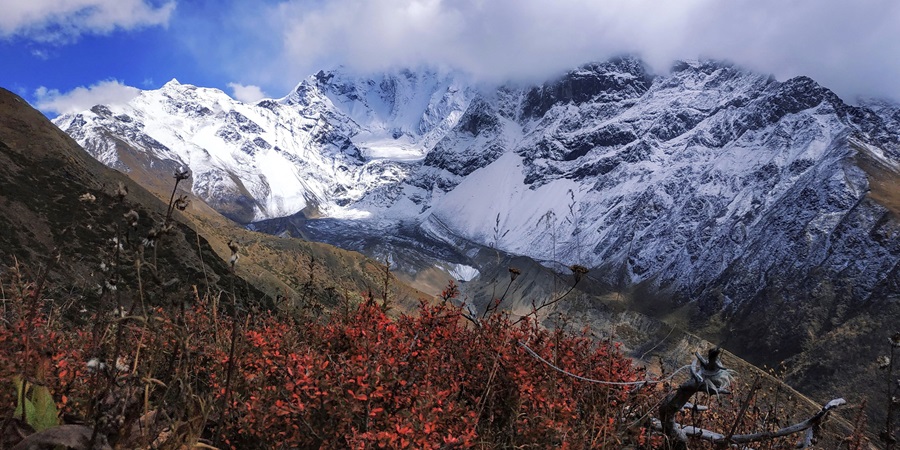
Elevation Gain and Breathtaking Views
The 610-meter ascent may be demanding, but it’s a path filled with unparalleled scenic rewards.
As you climb to higher altitudes, each step reveals ever-more stunning views of the Himalayan landscape, a panoramic spectacle that will leave you in awe.
The Rugged Terrain of the Manaslu Circuit
Renowned for its rugged terrain and demanding trails, the Manaslu Circuit Trek offers a genuine adventure for trekkers.
Today’s trek is a testament to the circuit’s reputation, presenting challenges that make the experience all the more fulfilling.

Connecting with Nature’s Wonders
The beauty of this trek lies in its ability to connect you intimately with the region’s natural wonders.
The Himalayas are not just mountains; they are a testament to the majesty of nature, and today’s trek brings you face-to-face with this grandeur.
Preparation and Anticipation
A sense of anticipation builds as you lace up your hiking boots and breathe the fresh mountain air.
Today is not just another day of trekking; it’s an opportunity to immerse yourself in the Himalayas’ heart, push your boundaries, and experience the thrill of achievement.
The Reward of Achievement
The effort required to conquer today’s 11-kilometre stretch is significant, but the sense of accomplishment you’ll feel upon completing it is even greater.
As you traverse this challenging segment of the Manaslu Circuit Trek, remember that each step is towards achieving something remarkable.

Today’s trek on the Manaslu Circuit is more than just a physical journey; it’s a journey of discovery and achievement.
It’s a day where you’ll witness the awe-inspiring beauty of the Himalayas and discover your strength and resilience.
Embrace the challenge, enjoy the journey, and prepare to be amazed by the incredible views that await.
The 18-kilometre segment of the Manaslu Circuit Trek leading to Larke Pass and subsequently to Bhimthang is the crown jewel of this adventurous journey.
This stretch is renowned for its awe-inspiring panoramic views and is a testament to the trek’s magnificence.
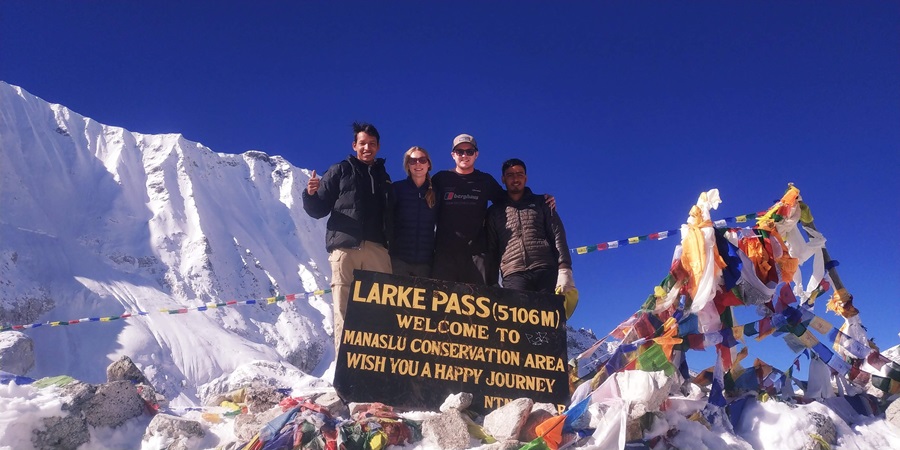
Elevation Gain and Challenge
One of the most notable aspects of this section is the elevation gain of 700 meters.
This significant ascent presents a physical and mental challenge to trekkers, pushing them to their limits while rewarding them with unparalleled scenic beauty and a profound sense of accomplishment.
Larke Pass – A Spectacular Vista
Reaching Larke Pass, which stands at an impressive altitude, is a moment of triumph for many trekkers.
This vantage point shows a breathtaking panorama of multiple mountain ranges.
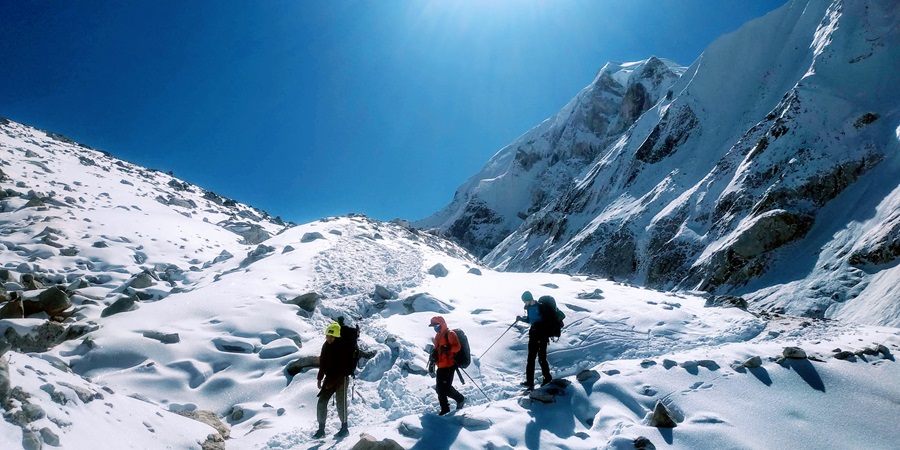
The sweeping views of the snow-capped peaks against the backdrop of deep blue skies create a picturesque and unforgettable scene.
Bhimthang – A Scenic Haven
After the exhilarating experience at Larke Pass, the journey towards Bhimthang offers a serene and captivating experience.
Bhimthang, known for its stunning landscapes, provides a tranquil environment to rest and reflect on the journey.
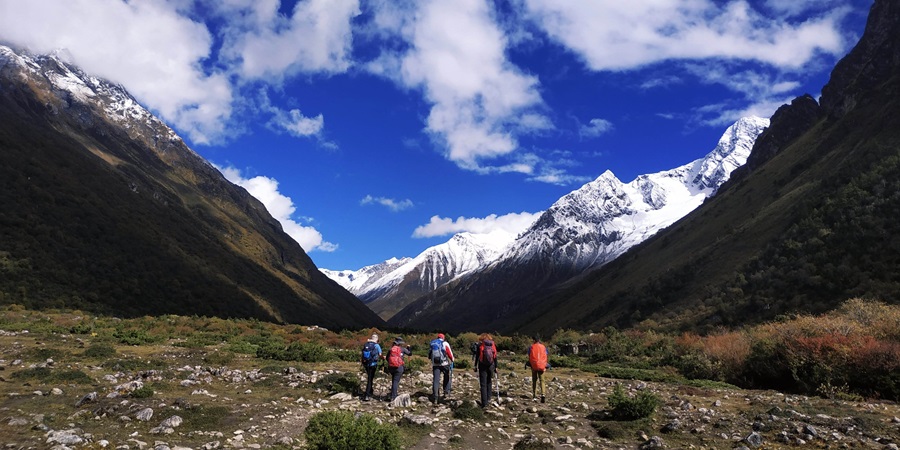
The Path through Diverse Landscapes
The trek to Larke Pass and Bhimthang is not just about the destination but also about the journey.
The path weaves through diverse landscapes, from verdant forests and meadows to rocky terrains and glacial paths.
This variation in scenery keeps the trek exciting and visually rewarding.
An Unforgettable Experience
Overall, this segment of the Manaslu Circuit Trek is not just a hike but an exploration into the heart of the Himalayas.
It’s an experience that blends the thrill of adventure with the beauty of nature, offering trekkers an opportunity to witness some of the most splendid views the Himalayas have.

The trek to Larke Pass and Bhimthang encapsulates the essence of the Manaslu Circuit Trek – a challenging, inspiring, and profoundly beautiful journey.
It’s a must-do for anyone seeking to explore the Himalayas and experience the grandeur of nature in its most majestic form.
Continuing your adventure on the Manaslu Circuit Trek, today’s journey involves a descent of 12 kilometres to Tilje and Dharapani, marking another captivating phase of your trek.
This segment is distinguished by its considerable elevation loss of 2,860 meters and the diverse terrains and ecosystems you’ll encounter.

Diverse Terrains and Ecosystems
As you descend from the higher altitudes, you’ll notice a significant change in the landscape and climate.
The trail will take you through varied terrains, from rocky paths and possibly snow-covered areas (depending on the season) to greener, more forested regions.
This transition offers a fascinating insight into the diverse ecosystems of the Himalayas.
Elevation Loss and Its Impact
The descent of 2,860 meters is substantial and requires careful navigation. Descending can be as challenging as ascending, especially on the knees and ankles.
It’s important to pace yourself, stay hydrated, and be mindful of the changing path conditions.
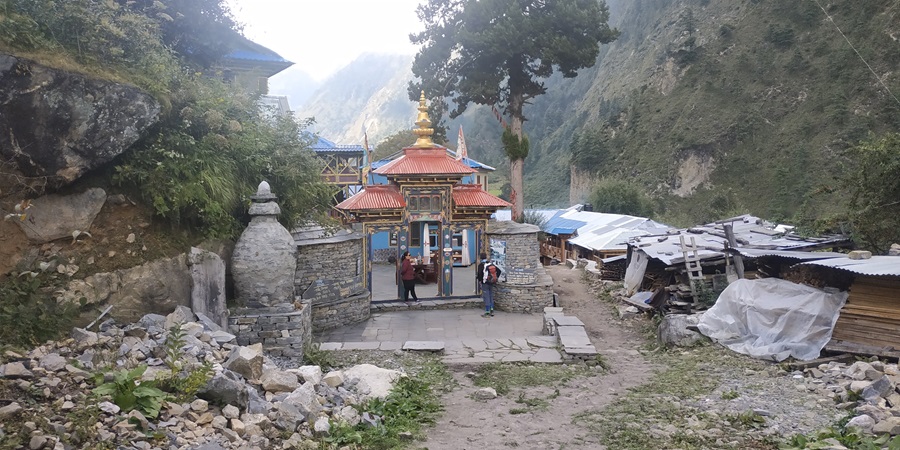
Tilje – A Cultural Experience
As you approach Tilje, you’ll be greeted by a different cultural landscape. This village offers a glimpse into the lifestyle of the local communities.
You can observe traditional houses and farming practices and possibly interact with the locals, adding a rich cultural dimension to your trek.
Dharapani – The Convergence Point
Dharapani is a significant point on the Manaslu Circuit Trek as it marks the convergence with another popular trekking route – the Annapurna Circuit.
This village is a trekking hub, providing amenities like teahouses and shops.

Witnessing Flora and Fauna
The descent through different altitudinal zones offers opportunities to observe a variety of flora and fauna that thrive in these ecosystems.
From alpine species to subtropical vegetation, the biodiversity enriches your trekking experience.
Rest and Reflection
As you reach Tilje and Dharapani, it’s a time for rest and reflection. This segment of the trek not only challenges your physical endurance but also allows you to absorb the natural beauty and cultural richness of the region.
The descent to Tilje and Dharapani is a journey through changing landscapes, offering a comprehensive experience of the Manaslu Circuit Trek.

It’s a day of physical challenge, cultural immersion, and natural exploration, adding another memorable chapter to your Himalayan adventure.
As you conclude your Manaslu Circuit Trek, the journey back to Kathmandu offers a reflective transition from the rugged trails of the Himalayas to the bustling life of Nepal’s capital.
While seemingly just a return, this segment of your adventure is an integral part of your overall trekking experience in Nepal.

Relishing the Return Journey
The drive back to Kathmandu is an opportunity to ponder your Manaslu Circuit Trekking experience.
As you move away from the remote areas of the Manaslu region, you’ll pass through changing landscapes that beautifully encapsulate the diversity of Nepal’s geography.
Manaslu Trek Nepal – A Journey of Contrasts
The Manaslu Trek in Nepal is renowned for its contrasts – from the high-altitude challenges near Larke Pass to the cultural richness in the lower regions.
As you head back, these contrasts become even more evident, showcasing Nepal’s unique blend of nature and culture.
Souvenir Shopping Post-Trek to Manaslu
With its bustling markets, Kathmandu is the perfect place to pick up souvenirs that remind you of your trek.
Whether traditional crafts, local art, or unique Nepalese spices, these items are a tangible memory of your journey.

Reflecting on the Manaslu Larke Pass Trek
The descent from Larke Pass is often a time for introspection. As the highest point of your trek, it symbolises a physical peak and a personal achievement.
Back in Kathmandu, you can look back on this achievement with a sense of pride.
Trekking in Manaslu – A Blend of Adventure and Culture
Your trek in the Manaslu region was more than just a physical challenge; it was a cultural immersion. Returning to Kathmandu signifies this immersion’s end, but the memories and lessons learned will stay with you forever.
Kathmandu – A Gateway to Trekking in Nepal
As you explore Kathmandu post-trek, you’re reminded that this city is not just Nepal’s capital but also a gateway to numerous other trekking adventures.
Your experience in Manaslu might encourage more explorations of this trekker’s paradise.
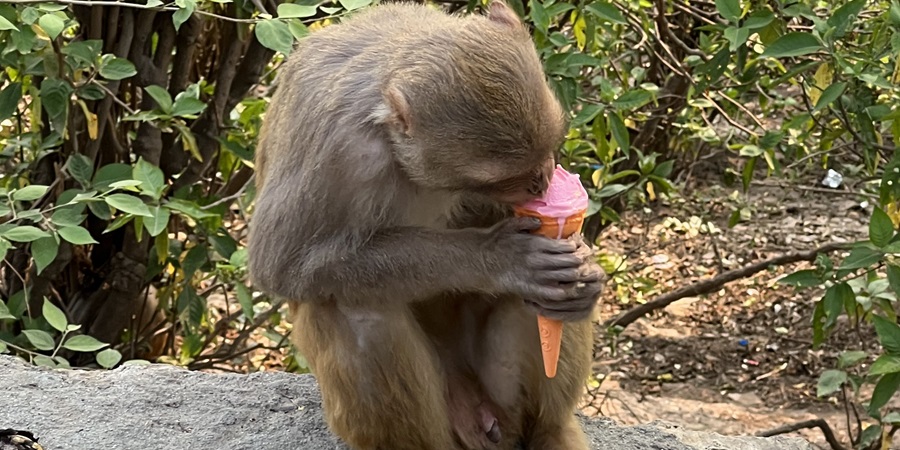
The journey back to Kathmandu is essential to the Manaslu Circuit Trek experience.
It allows you to transition from the solitude of the mountains to the lively rhythm of city life while carrying with you the memories and experiences of your incredible adventure trekking in Nepal.
At Trek Nepal Himalayas Pvt Ltd, we are dedicated to ensuring that your journey on the Manaslu Circuit Trek concludes with the same level of comfort and care that it began.
As your adventure ends, our team is committed to providing a seamless and stress-free transfer back to the Kathmandu airport.
We understand the importance of punctuality and comfort, especially after an exhilarating trekking experience in Nepal.

Our reliable transfer service is designed to give you a relaxing journey back to the airport, allowing you to reflect on the unforgettable memories you’ve created on the Manaslu Circuit.
With Trek Nepal Himalayas Pvt Ltd, your satisfaction and well-being are our top priorities, and we strive to ensure that every aspect of your trek, right up to your departure, is handled with the utmost professionalism and attention to detail.
Trust us to be your travel partner, not only on the trails of Manaslu but also on your journey back home.
Added Insights
Includes/Excludes
What's Included?
- Airport Transfers in Kathmandu: Begin and end your trekking adventure with hassle-free airport pickups and drops in a private vehicle, a convenient service for all trekkers arriving for the Manaslu Trek Nepal.
- Comfortable Accommodation: Enjoy 3-star hotel accommodations in Kathmandu, complete with breakfast. These hotels are perfectly suited for trekkers looking to relax before and after their trekking in Nepal.
- Cultural Richness of Kathmandu: Explore the cultural heritage of Kathmandu with a dedicated day for valley sightseeing, integral to the Manaslu Circuit Trekking experience.
- Authentic Teahouse Stays: Embrace the charm of the Himalayas with teahouse accommodations during your trek, offering a genuine trekking in Manaslu experience.
- Nutritious Meals on the Trek: Stay fueled with three daily meals (breakfast, lunch, and dinner) throughout your journey on the Manaslu Circuit.
- Welcoming and Farewell Dinners: Celebrate your Manaslu Circuit Trek adventure with special welcome and farewell dinners, offering a taste of Nepal’s culinary delights.
- All-Inclusive Transportation: Enjoy smooth transportation from Kathmandu to Sotikhola, and from Dharapani to Besisahar to Kathmandu, ensuring a comfortable journey throughout your trek.
- Entrance Fees and Sightseeing: All entrance fees for sightseeing and monument visits are included, adding depth to your Manaslu Trek Nepal experience.
- Experienced Trek Guides and Porters: Benefit from the knowledge and assistance of an experienced, English-speaking, government-licensed trek guide and porter services, enhancing your trek to Manaslu.
- Essential Trekking Gear: Stay comfortable with provided down jackets and sleeping bags, vital for the high-altitude conditions of the Manaslu Larke Pass Trek.
- Trekking Permits and Paperwork: We handle all necessary paperwork and permits, including National Park Permits and TIMS, essential for trekking in Manaslu.
- Safety with Medical Kit: A comprehensive medical kit is available for emergencies, prioritizing your safety on the Manaslu Circuit Trek.
What's Excluded?
- International Airfare: The cost of your flight to and from Nepal is a key expense outside the Manaslu Trek Nepal package. Allocate funds for your international travel to Kathmandu.
- Nepalese Visa Fee: Upon your arrival for the Manaslu Circuit Trekking, a Nepalese visa is mandatory. This fee is not included in your trek package and will be an additional cost.
- Travel and Rescue Insurance: Secure travel and rescue insurance for your trek to ensure safety and peace of mind. This is a crucial and personal responsibility for all Manaslu Larke Pass Trek trekkers.
- Excess Baggage Charges: If you exceed the luggage limit on flights or during the trek, be prepared to pay extra baggage charges.
- Extra Accommodation in Kathmandu: Plan for any additional nights in Kathmandu beyond your Manaslu Circuit Trek itinerary. Extra accommodation costs are not included in the package.
- Meals in Kathmandu: While some meals may be covered, typically lunch and dinner in Kathmandu will be out-of-pocket expenses during your trek to Manaslu.
- Personal Expenses: Budget for personal expenses such as phone calls, laundry, and other conveniences which are not included in the trek package.
- Tipping on the Manaslu Circuit: Tipping your guides and porters is a customary practice in Nepal and is not included in the package cost. It’s a way to show appreciation for their assistance during your trek.
Complete Guide to Manaslu Circuit Trek
Best Seasons for Your Manaslu Circuit Trek Adventure
Choosing the ideal time for your Manaslu Circuit Trek is a crucial decision that can significantly impact your overall experience in the mesmerizing Himalayas of Nepal. This renowned trek features distinct seasons, each offering unique charm and challenges.
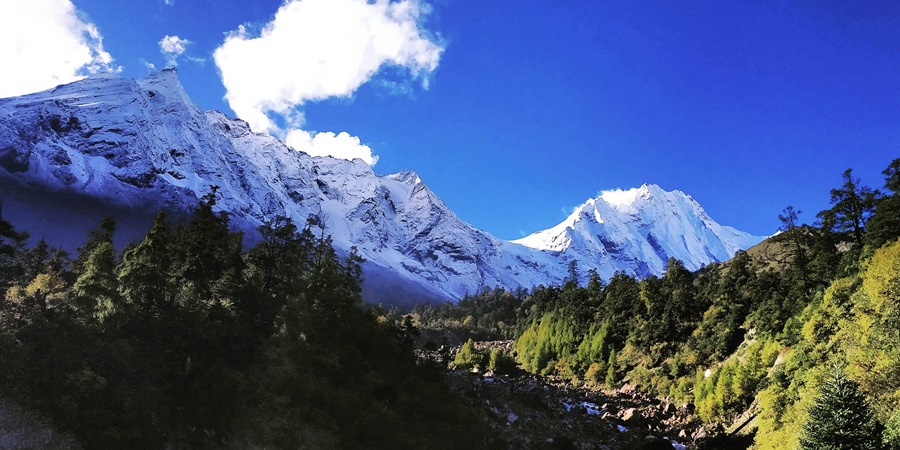
Autumn: A Mesmerizing Blend of Clarity and Comfort (September to November)
Embarking on the Manaslu Circuit Trek from September to November during autumn promises an extraordinary journey filled with clarity and comfort. During this season, the skies are typically clear, providing unobstructed vistas of the majestic Manaslu range. The Larke Pass, a significant highlight of the trek, becomes more accessible and less challenging regarding weather conditions.
The cool, pleasant temperatures make trekking through the diverse landscapes, including lush forests and culturally rich villages, a delightful experience. Autumn is widely regarded as the best time for the Manaslu Circuit Trek, offering the perfect blend of favourable weather and captivating scenery.
Spring: Immerse Yourself in a Floral Wonderland (March to May)
Spring, which unfolds from March to May, is another exceptional season for the Manaslu Circuit Trek. This period transforms the trekking trails into a mesmerizing floral wonderland as abundant rhododendrons and various alpine flowers bloom. Trekking amidst this vibrant display of colours is a visual treat for nature enthusiasts and photographers alike.
The breathtaking contrast of the colourful blossoms against the backdrop of snow-capped peaks creates a picture-perfect setting. Spring is ideal for those who appreciate botany and want to witness Nepal’s rich biodiversity while enjoying panoramic mountain views.

Winter and Monsoon: The Untamed Seasons
While less frequent, the winter months (December to February) and the monsoon season (June to August) present unique opportunities and challenges for adventurous trekkers. These seasons are recommended for experienced hikers seeking solitude or a more strenuous Manaslu Larke Pass Trek.
Both winter and monsoon demand special preparations due to the harsh conditions at the Larke Pass, including snow and ice in winter and the risk of landslides and rain in monsoon. However, for those seeking tranquillity and untouched landscapes, these seasons offer a distinct and rewarding trekking experience in the remote Himalayas.
Choosing the right season aligns your Manaslu Circuit Trek with your preferences and trekking objectives, ensuring an unforgettable adventure amidst the Himalayan grandeur.
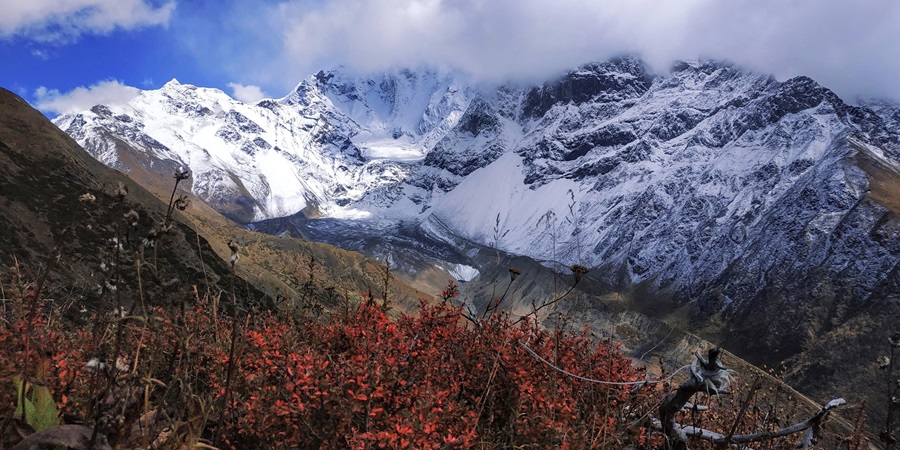
Essential Permits for Your Manaslu Circuit Trek Adventure
Embarking on the mesmerizing Manaslu Circuit Trek is a lifetime journey, but being well-prepared with the necessary permits is essential. This remarkable trek takes you through a restricted area and a conservation zone, requiring specific licenses to ensure a smooth and responsible trekking experience.
Manaslu Restricted Area Permit
The Manaslu Circuit Trek is classified as a restricted area trek, meaning all foreign nationals must obtain a Manaslu Restricted Area Permit. This permit is your gateway to exploring the remote and breathtaking regions surrounding Mount Manaslu.
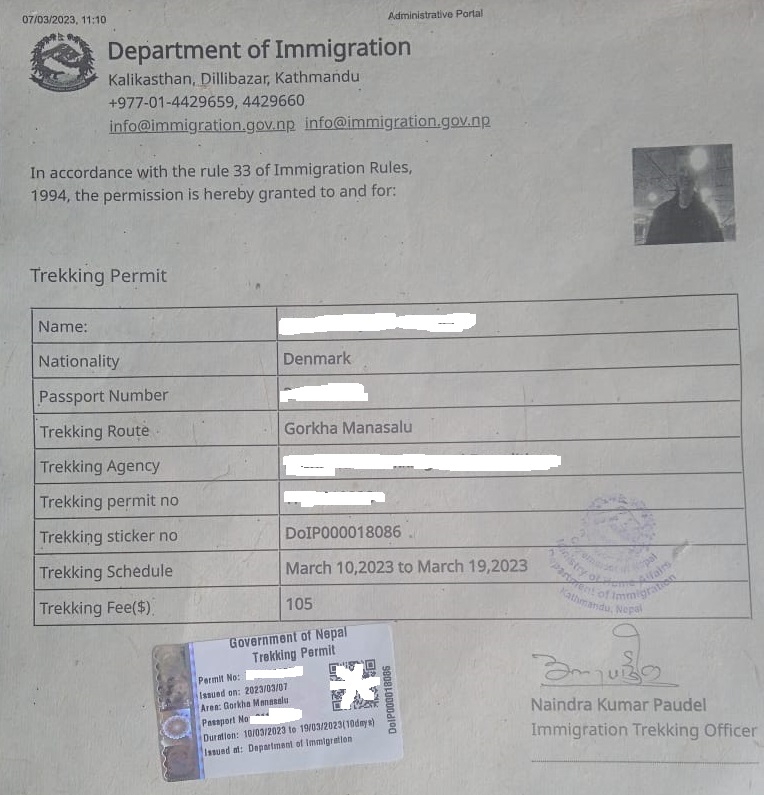
It’s a crucial document that grants you access to the restricted zones along the trekking route. Without it, you won’t be able to explore the captivating landscapes, interact with local communities, or immerse yourself in the culture and traditions of the Manaslu region. Ensure you secure your Manaslu Restricted Area Permit well in advance to avoid any inconveniences during your trek.
Annapurna Conservation Area Permit (ACAP)
A portion of the Manaslu Circuit Trek intersects with the Annapurna Conservation Area, a pristine natural environment teeming with biodiversity. To support responsible trekking in Nepal and contribute to the conservation efforts in this area, obtaining an Annapurna Conservation Area Permit (ACAP) is mandatory.
This permit allows you to trek through the Annapurna region’s stunning landscapes while protecting its unique flora and fauna. By acquiring the ACAP, you become a part of the collective effort to preserve Nepal’s natural heritage.

Manaslu Conservation Area Permit (MCAP)
In addition to the Annapurna Conservation Area, the Manaslu Circuit Trek also passes through the Manaslu Conservation Area. You must obtain a Manaslu Conservation Area Permit (MCAP) to trek through this pristine and ecologically important region.
This permit is a vital component of responsible trekking and contributes to the conservation and sustainability of the Manaslu region. Securing the MCAP significantly preserves the area’s natural beauty and cultural heritage while supporting local communities.
Uncover the Basics: Accommodation and Dining on the Manaslu Circuit Trek
When embarking on the awe-inspiring Manaslu Circuit Trek, understanding the fundamentals of accommodation and dining is crucial for a comfortable and memorable journey.
Traditional Teahouses: The Heart and Soul of Trekking in Nepal
Throughout your Manaslu Circuit Trek, teahouses will become your home away from home. These charming local lodges are the cornerstone of accommodation in the region, offering trekkers a place to rest, refuel, and immerse themselves in the warmth of local hospitality.

Teahouses provide basic amenities, including a comfortable bed, warm blankets, and hearty meals. However, the true essence of teahouses lies in the rich cultural experience they offer. From engaging with friendly locals to savouring authentic Nepalese cuisine, your stay at teahouses will be a memorable part of your Manaslu Circuit trekking adventure.
Camping: The Road Less Traveled
While teahouses are the prevalent choice for accommodation on the Manaslu Circuit, camping provides a more adventurous alternative. Camping can be arranged upon request and involves an additional cost.
This option lets you venture off the beaten path, experiencing solitude and a deeper connection with nature. Camping on the Manaslu Circuit Trek is a unique opportunity to camp beneath the star-studded Himalayan skies and wake up to the pristine beauty of the mountains.
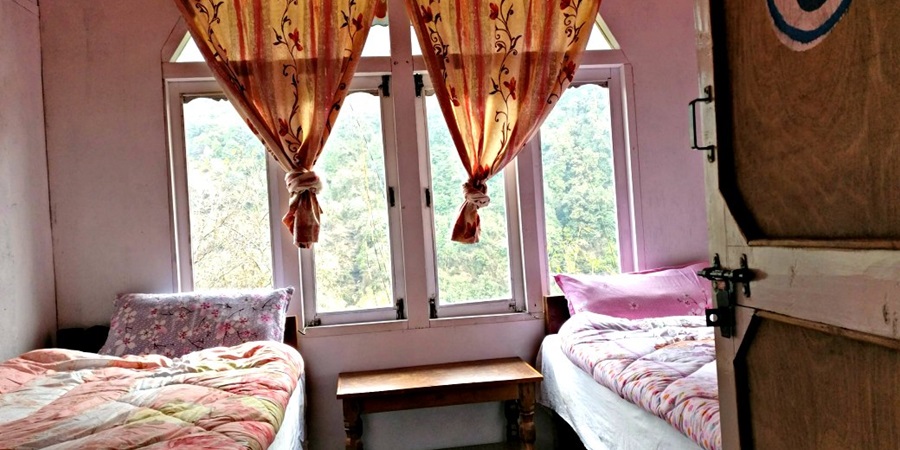
Food Options During the Manaslu Circuit Trek
Your journey along the Manaslu Circuit is a feast for the eyes and a culinary adventure. Understanding your food choices is essential as you’ll spend considerable time away from urban centres.
Local Teahouse Cuisine: Comfort Foods in the Mountains
Most trekkers on the Manaslu Circuit stay in teahouses offering diverse local and international dishes. You can expect to savour traditional Nepalese delights like “dal bhat” (lentil soup and rice) and various other options, including fried rice, pasta, and even Western cuisines. These hearty meals are designed to provide the energy needed for the challenges of Manaslu Circuit trekking while offering a taste of authentic local flavours.
Packaged Foods: Convenient but Limited
Some trekkers carry packaged foods such as energy bars, dried fruits, and nuts. While these items offer convenience, they should complement teahouses’ more nutritious and satisfying meals.
Dietary Restrictions: Communicate in Advance
If you have specific dietary requirements or restrictions, it’s advisable to communicate them when booking your trek. Most teahouses can accommodate dietary preferences such as vegetarian or gluten-free options if notified in advance, ensuring you have a comfortable and enjoyable dining experience.
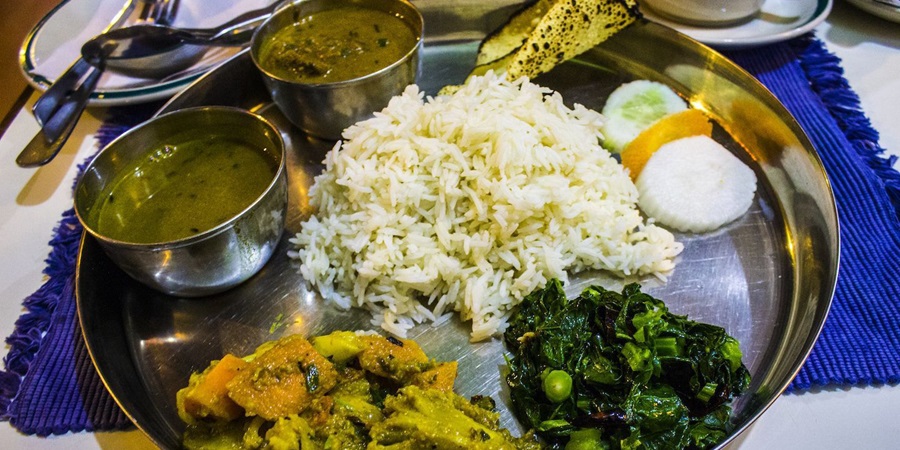
A Word on Alcohol
Consuming alcohol at high altitudes is generally discouraged due to its dehydrating effects and the increased risk of altitude sickness. It’s advisable to save any celebratory drinks for your return to Kathmandu, where you can toast the success of your remarkable Manaslu Circuit Trek.
Manaslu Circuit Trek: Staying Hydrated in the Himalayas
Proper hydration is essential for your well-being during the Manaslu Circuit Trek, a remarkable journey through the Himalayas. With Manaslu Circuit Trek as our focus keyword, we’ll explore the best ways to stay hydrated while trekking and incorporate relevant secondary keywords to enhance the content.
Primary Water Sources: Teahouses and Local Outlets
Along the Manaslu Circuit Trek, teahouses are trekkers’ primary drinking water sources. These teahouses provide boiled or filtered water and are strategically placed along the trekking route. Having some local currency on hand is advisable for purchasing water at these teahouses to ensure you stay well-hydrated during your “Manaslu trekking” adventure.

Natural Springs: Proceed with Caution
While trekking in the Manaslu Circuit, you may encounter natural water sources like mountain springs. While drinking fresh mountain spring water is appealing, it’s essential to exercise caution.
These natural water sources can sometimes contain harmful bacteria or parasites, so treating the water before consumption is recommended, especially during your “Manaslu trek in Nepal.”
Water Treatment Options: Purification Tablets and Filters
For added safety during your “Manaslu Circuit trekking in Nepal,” consider carrying water purification tablets or a portable water filter. These lightweight solutions effectively neutralize a wide range of waterborne pathogens, ensuring water is safe for your health and hydration needs.
Bottled Water: Environmental Considerations
While bottled water is available along the trekking route, its use raises environmental concerns due to plastic waste. Given the pristine nature of the Manaslu Circuit, responsible trekking is essential. Opt for reusable water bottles and employ water treatment methods whenever possible to minimize environmental impact while “trekking in Manaslu.”
Recommended Hydration Levels: Enjoy Your Trek
Due to the physical demands of trekking at high altitudes and the dry mountain air, staying well-hydrated is crucial. Experts recommend drinking at least 3-4 litres of water daily while trekking and even more if you’re sweating heavily. Proper hydration enhances your overall “Manaslu Circuit trekking experience,” allowing you to fully appreciate the breathtaking views and cultural encounters that make this trek unforgettable.
Hot Showers on the Manaslu Circuit Trek: What to Expect
When embarking on the Manaslu Circuit Trek, understanding the availability of hot showers is essential for a more comfortable journey. We’ll explore what you can anticipate regarding hot showers while trekking the Manaslu Circuit.
Teahouses: The Primary Accommodation
Throughout the Manaslu Circuit Trek, teahouses serve as your primary accommodation. While these rustic lodges offer basic comforts, it’s important to note that hot showers are not a standard feature. Some teahouses may provide the option of hot showers, often at an additional cost and subject to availability.
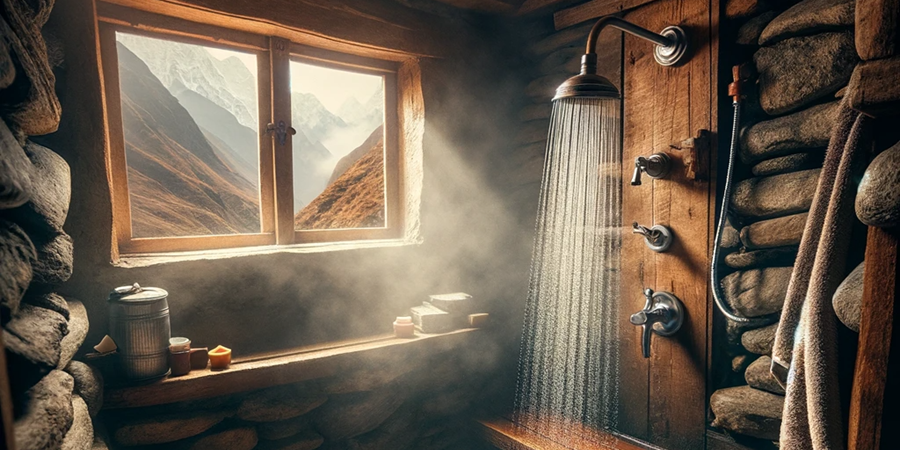
Heating Methods: Gas and Solar
Where hot showers are available, they are typically heated using either gas or solar energy. Gas-heated showers depend on a stable gas supply, while weather conditions influence solar-heated showers. As a result, even if hot showers are advertised, they may not always be guaranteed during your “Manaslu Circuit trek.”
Bucket Showers: A Traditional Refreshment
You may encounter the traditional bucket shower in more remote areas along the trek. While not as luxurious as a hot shower, a bucket shower can provide a refreshing experience after a strenuous day of trekking.

Planning Ahead: Wet Wipes and Dry Shampoo
Given the limited availability of hot showers, packing essentials like no-rinse body wipes and dry shampoo is advisable. These items can help you freshen up when a hot shower is not an option, enhancing your overall Manaslu Circuit trekking experience.
Environmental Considerations: Water Conservation
Trekking in the Manaslu region allows you to connect with nature, and practising responsible trekking includes minimizing water usage. If you indulge in a hot shower, keep it brief to conserve water and energy, aligning with eco-friendly trekking principles.
Whether you’re a seasoned trekker or embarking on your first Himalayan adventure, having realistic expectations about hot showers during the Manaslu Circuit Trek can contribute to a more enjoyable and well-prepared journey.
Electricity and Wi-Fi on the Manaslu Circuit Trek: What You Should Know
Trekking the Manaslu Circuit provides a unique opportunity to disconnect from the modern world and immerse yourself in nature and culture. However, complete isolation may not always be practical or desirable in today’s connected age. Here’s what you need to know about the availability of Wi-Fi and electricity during your journey.
Teahouse Amenities: Available at Additional Cost
Most teahouses along the Manaslu Circuit Trek offer Wi-Fi and electricity services, but it’s essential to know that these conveniences are typically accessible. The cost can vary depending on the teahouse’s location and altitude.
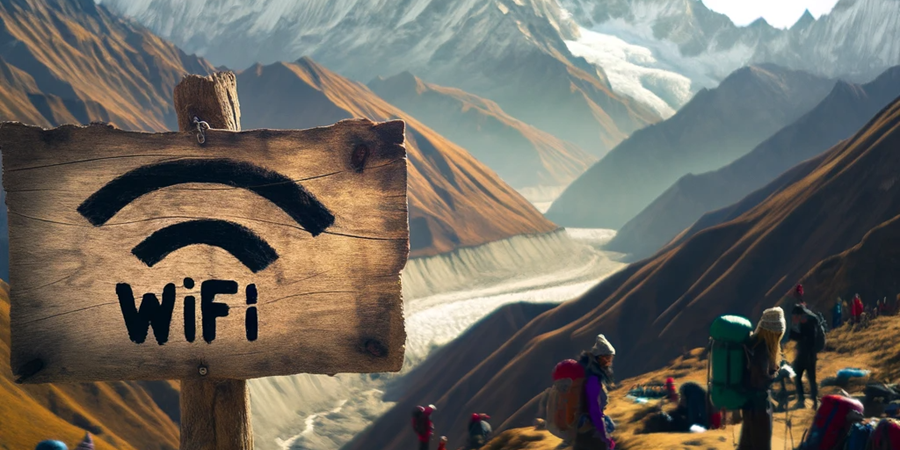
Wi-Fi: Serviceable but Limited
While Wi-Fi is accessible in many teahouses, managing your expectations is essential. The Wi-Fi connection in these remote areas may not match the speed and reliability of urban networks. While it’s suitable for basic tasks like checking emails and social media updates, bandwidth-intensive activities such as video streaming or large file downloads may be challenging.
Electricity: Charging Your Devices
Teahouses typically provide electrical outlets for charging your devices, such as smartphones, cameras, and portable chargers. However, the electricity supply can be erratic due to the remote locations. A portable power bank is advisable to ensure your devices remain charged during your Manaslu Circuit trek.
Offline Preparation: Embrace the Disconnect
While it’s helpful to know about the availability of Wi-Fi and electricity, embracing the opportunity to disconnect and fully engage with the natural beauty and cultural richness of the Manaslu region can enhance your overall trekking experience.

Whether you stay connected or relish the moments of disconnection, understanding the options available for Wi-Fi and electricity can help you make informed decisions for a more enjoyable and well-prepared Manaslu Circuit Trek.
Electricity on the Manaslu Circuit Trek: Charge Up Wisely
Electricity is available for charging electronic devices like smartphones and cameras during the Manaslu Circuit Trek. However, considering the remote location and limited supply, it’s essential to use electricity sparingly. As you ascend to higher altitudes, electricity costs may increase at teahouses. To minimize reliance on teahouse electricity and ensure your devices stay powered, it’s advisable to bring extra batteries or a portable charger with you on your trek.
Mobile Connections: Unreliable on the Manaslu Circuit Trek
While Nepal Telecom (NTC) or NCELL mobile network coverage is generally excellent in most parts of Nepal, it’s not the best option for maintaining a reliable mobile connection during the Manaslu Circuit Trek. Signal strength can be inconsistent, and data connectivity is often weak or non-existent along the trekking route.

Planning Ahead: Managing Your Connectivity Needs
To overcome these challenges, planning and managing your electronic needs wisely before your trek and downloading maps, guides, and entertainment content for offline use is essential. Additionally, consider carrying a lightweight solar charger to ensure you have a backup power source in emergencies.
Eco-Friendly Reminder: Responsible Resource Use
As responsible trekkers, it’s crucial to use these electronic resources responsibly to minimize your environmental impact on the pristine landscape of the Manaslu Circuit. Understanding the limitations of mobile connections, Wi-Fi, and electricity availability allows you to prepare effectively for your trek, ensuring you can fully immerse yourself in the breathtaking scenery and rich cultural experiences this remarkable route offers.
Why Travel Insurance is Essential for Manaslu Circuit Trek
Embarking on the Manaslu Circuit Trek is an adventure of a lifetime, offering trekkers the chance to experience unique Tibetan culture, stunning Himalayan landscapes, and the thrill of crossing the Larke Pass. However, taking proper precautions is essential, and securing a comprehensive travel insurance package should be on your list.

High-Altitude Rescue and Evacuation
The Manaslu Circuit Trek involves traversing high-altitude terrains, including the challenging Larke Pass. At such elevations, the risk of altitude sickness is real. Your travel insurance should cover emergency high-altitude rescue and evacuation to the nearest medical facility.
- Medical Coverage: While the trek is moderately complex, accidents can happen. Insurance covering medical expenses, including hospitalization and medication, is crucial.
- Trip Cancellation or Interruption: Whether it’s due to bad weather, political instability, or personal emergencies, there’s always the risk of trip cancellations. A good travel insurance package will cover the costs incurred due to unexpected cancellations or interruptions.
- Loss or Theft of Belongings: While the Manaslu Circuit is generally safe, you can lose your belongings or face theft. Insurance that covers losing essential items like passports, electronics, and trekking gear can offer peace of mind.
- Legal Assistance: Should you encounter any legal issues while on your trek, some insurance packages offer coverage for legal advice and other related costs.

How to Choose the Right Insurance
- Read the Fine Print: Always read the terms and conditions of your travel insurance policy carefully. Make sure high-altitude trekking is covered.
- Check the Maximum Altitude: Ensure the policy covers trekking up to the altitudes you’ll reach on the Manaslu Circuit Trek.
- Customer Support: Opt for providers that offer 24/7 customer support, as you never know when you’ll need it.
- Compare Multiple Options: Before settling on a policy, compare multiple travel insurance options to ensure you’re getting the best coverage for your money.
By securing a comprehensive travel insurance package, you’re not just buying peace of mind but investing in an uninterrupted and more enjoyable Manaslu Circuit Trekking experience.
Money Management Tips for Manaslu Circuit Trek
Venturing into the remote and awe-inspiring terrains of the Manaslu Circuit Trek demands careful financial planning, mainly due to the trek’s isolation. Here’s why and how you should efficiently manage your finances before departing from Kathmandu.

Challenges of Limited Banking Facilities
Unlike popular trekking routes like Annapurna or Everest, the Manaslu Circuit is a relatively remote destination with scarce or nonexistent access to banking facilities. While you may come across small shops accepting digital payments, it’s crucial to understand that cash remains the most reliable currency.
The Wisdom of Preparing Finances in Kathmandu
- Diverse Banking Options: Kathmandu offers a plethora of banks and ATMs where you can withdraw an adequate amount of cash for your trek, ensuring you won’t run short of funds during your journey.
- Currency Exchange Opportunities: Kathmandu boasts numerous reputable exchange centres offering competitive rates for travellers carrying foreign currency, allowing you to exchange your money conveniently.
- Strategic Budgeting: Prioritizing your expenses and creating a well-structured budget is essential. Account for vital aspects such as accommodation, meals, and potential costs like hiring guides, porters, and leaving tips. Always retain some cash as a contingency fund to address unforeseen circumstances.
- Cost-Effective Purchases: Kathmandu provides the advantage of more affordable gear and supplies than smaller towns or villages along the trek route. Stocking up on essentials in the capital city can help you save money.
Practical Finance Management Tips
- Diversify Denominations: Ensure your cash holdings include both large and small denominations. Smaller notes are beneficial for tipping or purchasing small items like water and snacks during your trek.
- Waterproof Protection: Safeguard your cash by storing it in a waterproof pouch. This extra precaution shields your money from the elements, including rain and moisture.
- Backup Solutions: While cash is indispensable, having a secondary financial tool, such as a travel money card, for emergencies can provide added financial security during your trek.
- Emergency Fund: Consider setting aside a separate stash of cash exclusively for emergencies. This reserve should remain untouched unless necessary.

By proactively managing your finances in Kathmandu, you’ll ensure that your Manaslu Circuit Trek unfolds seamlessly, immersing yourself in the breathtaking vistas and remarkable cultural encounters that define this exceptional journey.
Top 10 FAQs for Manaslu Circuit Trek
Yes, you’ll need a Manaslu Restricted Area Permit, the Manaslu Conservation Area Project (MCAP) permit and the Annapurna Conservation Area Project (ACAP) permit. These are mandatory and can be acquired in Kathmandu.
The best seasons for trekking the Manaslu Circuit are the pre-monsoon Spring (March to May) and post-monsoon Autumn (September to November) when the weather is more stable and the visibility is excellent.
The Manaslu Circuit Trek is moderately complex, featuring some challenging sections, particularly when crossing the Larke Pass. Adequate physical preparation is recommended.
The trek offers teahouse/lodge accommodation. These are basic yet comfortable, with no luxury options available. Most teahouses provide twin-sharing rooms without attached bathrooms.
Expect to dine on traditional Nepalese food like dal-bhat, Tibetan influences and essential international dishes. Fresh fruit is generally served after meals.
Safe drinking water can be scarce. Carrying water purification tablets or using a portable water filter is advisable. You can also buy bottled water, but it gets increasingly expensive as you ascend.
Hot showers are usually available at teahouses for an extra charge. Remember that hot water can be scarce higher up on the trek.
Wi-Fi and electricity are available at teahouses for an extra fee, but the connection can be spotty as you get closer to higher elevations.
The mobile network along the Manaslu Circuit is inconsistent. While NTC and Ncell networks are available, they aren’t reliable for the entire journey.
It’s highly recommended to have a comprehensive travel insurance policy covering emergency high-altitude rescue and evacuation and standard medical coverage.
Reviews on Manaslu Circuit Trek
![]()
![]()
![]()
![]()
![]()
Based on 3
Reviews

Mambo
Indonesia
Awesome trip to Manaslu
Indeed, with its relatively recent opening to international trekkers, the Manaslu Circuit promises serenity with fewer crowds. This ensures an intimate communion with nature, untouched landscapes, and authentic cultural experiences.

Nimo
Australia
One of the best rip
Indeed, with its relatively recent opening to international trekkers, the Manaslu Circuit promises serenity with fewer crowds. This ensures an intimate communion with nature, untouched landscapes, and authentic cultural experiences.

Halen Krim
London
Thanks for the amazing trip
Indeed, with its relatively recent opening to international trekkers, the Manaslu Circuit promises serenity with fewer crowds. This ensures an intimate communion with nature, untouched landscapes, and authentic cultural experiences.
